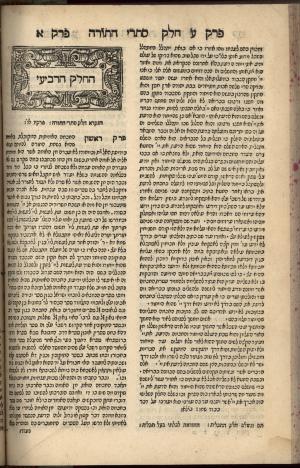Obj. ID: 38706
Jewish printed books Avodat ha-Kodesh by Meir ben Yechezkiel Gabai, Cracow, 1577

This text was prepared by William Gross:
Avodat HaKodesh, on matters pertaining to Kabbalah and G-d's service, by Rabbi Meir Gabai. Cracow, 1576-1577, printed by Yitzchak of Prostějov (Prostich). First edition with this name [printed previously in Venice in 1567 with the title Marot Elokim]. The title page features the date of the beginning of the printing of the book - Cheshvan 1576, and the last leaf is a colophon with the date it was concluded – Cheshvan 1577.
A four-part exposition on the kabbalah, and the most important work of renowned kabbalist Meir b. Yechezkiel ibn Gabbai.
Meir ben Ezekiel ibn Gabbai (Hebrew: מאיר בן יחזקאל אבן גבאי) was a kabbalist born in Spain toward the end of 1480, and experienced the Expulsion of 1492. He eventually resettled in Egypt. He must have had a life of some hardship, even after resettling, for at the end of his work the Tola'at Ya'aḳov, he complains of how hard he has to labor to support himself and his family.
Meir b. Ezekiel was an enthusiastic kabbalist, noted for his mastery of the whole kabbalistic lore, the most important points of which he, as far as can be judged now, was the first of his generation to treat systematically. He must be regarded, therefore, as the precursor of Moshe Cordovero and Isaac Luria. His first work, completed in 1507 and held in high regard, was Tola'at Ya'aḳov, a kabbalistic exposition of the prayers. His chief work, which he finished on 22 December 1531, after laboring on it for eight years, was Avodat Hakodesh, in which he expounds in detail his kabbalistic system, making a close study of Maimonides in order the better to refute him. In 1539 he wrote an exposition and defense of the Sefirot under the title Derekh Emunah, in answer to his pupil Joseph ha-Levi, who had questioned him in regard to his doctrine of the Sefirot. R.Gabbai based his work on Azriel of Gerona's Perush 'Eser Sefirot.
The printer Isaac Prostitz, born in Prossnitz, Moravia, was sent at an early age to Italy by his father to learn the printing trade, accomplished at the Cavalli and Gryphios presses. When the latter press closed in 1568, Prostitz acquired their typographical equipment, including the letters, ornaments, and frames, and brought them to Cracow, where he was joined by the famous proofreader R. Samuel Boehm. Prostitz petitioned King Sigismund II Augustus on 15 October 1567 for the privilege of establishing a Hebrew press, which was granted to him and "his seed after him" to print the Talmud and other Hebrew books for a period of fifty years. Prostitz would, until his death in 1611, print more than 200 titles. The press was continued by his sons, Aaron and Issachar, after his death, and their sons after them.





